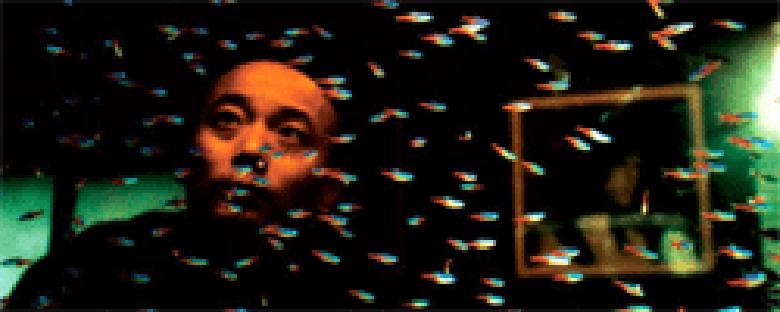Reviews
Zhixi
Bingjian Zhang
China, 2005
Credits
Review by Marlin Tyree
Posted on 26 October 2006
Source Hoker Records DVD
Related articles
Features: 31 Days of Horror
Creating an effective twist ending to a film involving a schizophrenic main protagonist and a seemingly absentminded shrink is surely a difficult endeavor. It’s increasingly unlikely to work if part of your ambition is to make the audience feel as if they’ve hallucinated the previous 90 minutes. Zhang Bingjian, with his first feature length film, may believe that elements of a film’s plot are indistinguishable from elements arising from a character’s psychological projections, but it’s a disingenuous approach to storytelling and induces mistrust in any attentive viewer, to say the least. On the other hand, there is so much visual artistry to Zhixi (Suffocation, as it’s called here in the States) that one may dispense with narrative logic and proceed with delight, all while the main character is hounded by demons of his own devising.
Ostensibly, the film, adapted from a novel by its screenwriter Xiaoni Gu, concerns an emotionally and psychologically disturbed photographer, Chien Xiao, who murders his wife and is subsequently haunted by her ghost. The film opens with a quote from Sigmund Freud, which may send more discerning moviegoers running for the exit signs. The narrative begins in the Chien’s psychotherapist’s office and commences with a series of variations on the murder of his wife and the disposal of her body. The trouble with this approach as handled by Bingjian is that the flashbacks involving the sessions of psychotherapy do not come at regular intervals, so they do not function as an effective film refrain (though they certainly are a tip that the treatment isn’t working). The point is that the logic of their occurrence remains a mystery.
This point can be extended to the film as whole: for example, what exactly is the basis for the reoccurring visual motifs? As we discover, rather late in the film, Chien’s childhood conflict with his father set a pattern of feeling emotionally strangled or “suffocated” in his subsequent personal relationships. If Bingjian is using archetypal dream symbols and dream language (the cinematography is outstanding, and clearly the centerpiece of the film) to give us an insight into the ruminations of the Chien’s emotional and psychological world, the narrative doesn’t make clear when this language begins and when it ends. The inclusion of the Chien’s best friend and his obviously suspicious spouse would seem to provide a touchstone of reality and the therapist’s pointed comment that, in fact, the photographer has lost his mind begs the following: are we watching the world though the eyes of the main protagonist or are we a third party inheriting every character’s perspective? We don’t really see enough of the other characters for the former to be true, but then, how do the reactions of the other characters enter Chien’s consciousness? If we’re accompanying Chien’s emotional and psychological journey exclusively, why do we leave him at all? Mind, we only ask these questions while the film is running, which, I have to believe, is part of what Bingjian wants us to ponder.
Thematic and narrative concerns aside, the film remains a compellingly frightening, if frustrating, visual experience. You Ge, as Chien, is absolutely fascinating to watch, and Bingjian takes full advantage of You’s imposing physical presence. Xiaobing Rao’s camerawork is alternatively breathtaking and uncannily menacing. The cinematography, however, takes us only halfway there. The use of sound instills a sense of suspense, providing auditory clues and narrative information, and is employed to maximum effect. It is used so deftly that the viewer is kept on the edge of his seat even when the effect seems completely illogical. There’s a moment, early in the film, for instance, when the slow menace of the tracking camera gives us a sense that Chien’s wife is being watched, that the screen goes black and we hear something akin to a gun shot. Familiar with this effect in horror/thriller films, we automatically assume she’s been shot. When we hear the same sound later as a car hood slams we realize that we’ve been hoodwinked, not only regarding the method of her killing but also the meaning of the sound itself. Bingjian repeats this, not merely with visual motifs and sound effects, but, as stated above, with the logic of the plot’s structure as well.
Bingjian’s chief aim, it seems, is to make us as thoroughly disoriented as the main character, which seems to be enough for the requirements of this horror film—the conclusion leaves us as bewildered as the moment we started watching the hapless Chien. It makes me wonder if horror, by definition, is some kind of sub-genre of tragedy—a kind of toss-off for those without the discipline to be really rigorous with their vision. Or perhaps I simply lack a sense of humor. I’d have welcomed a laugh if once during this otherwise magnificently shot film the ghost of the wife slapped the tortured photographer with a derisive, “Snap out of it!” But then that would be too straight for Bienjian’s kind of fun.
We don’t do comments anymore, but you may contact us here or find us on Twitter or Facebook.



